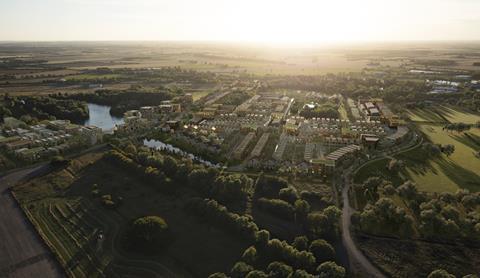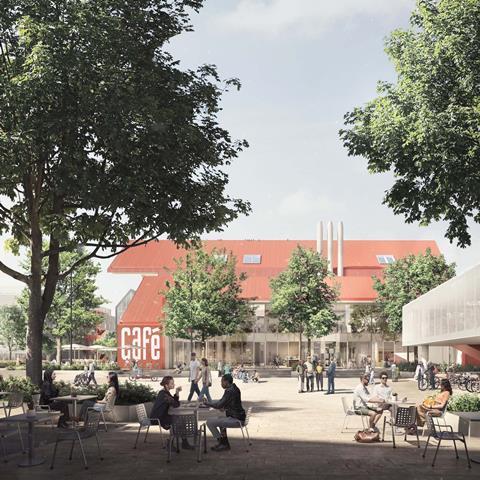The arrival of thousands of new homes and jobs alongside existing communities can sound daunting to existing residents. But developments such as Waterbeach and Oxford North, which support the thriving knowledge economies of Cambridge and Oxford, can enhance lives across the board, writes Jonathan Kendall of Fletcher Priest, masterplanner for both projects

The attitudes of the UK’s main political parties towards urban development have become markedly different in recent weeks. Cross-party consensus, badly needed to achieve long-term change, is slow to create and hard to rebuild.

We have seen the government pull the rug from under much of HS2, one of the largest infrastructure projects in decades. Meanwhile, the Labour Party has made bold claims around delivering more homes through an ambitious series of new town projects.
Against a backdrop of well-documented pressure for badly needed new homes there are lessons we can learn from our experience over the past decade. We have had the good fortune to work in parallel on two examples of major development that illustrate potential models for urban change: redefinition of a city’s edge versus the creation of new satellite communities.
Waterbeach, to the north of Cambridge, essentially represents the creation of a new Fen-edge town separate from but clearly interdependent with its host, residentially-led with thousands of homes well connected to employment activity in and around the city. It’s a master development model that Urban&Civic has been pioneering over recent years.
Oxford North by contrast – employment-led and mixed-use – sits within the administrative boundary of its historic city and will become embedded in its urban fabric. Our client there is a joint venture between Thomas White Oxford, the development company of St John’s College Oxford, working with Cadillac Fairview and Stanhope. Each project highlights the necessarily close relationship between infrastructure, hi-tech employment space and new places for people to live in.

Inevitably there are always questions around how best to deliver such schemes. In leading the design of these projects, working with committed long-term clients, we seek to explore how they can function to offer the best experience for those who live and work in and around them. A key question is how they can be delivered and occupied without alienating those who already live in the area.
Building significant numbers of new homes and other uses next to existing communities can be daunting for those living nearby. But if one is determined to build at scale, and meaningfully include social infrastructure – schools, community uses and other facilities – it is possible to demonstrate that new development can positively improve the lives of existing residents.
Key to the success of such schemes is the interplay between the infrastructures of movement – public transport, cycle accessibility, safe walking – and where people live, work, and spend their leisure time.
Spurred on by our experience from these live projects, and others, we were keen to explore broader questions of placemaking along the Oxford to Cambridge arc when we were finalists in the National Infrastructure Commission’s ideas competition. Our research has spoken hugely to our own experiences at either end of that corridor.
So often one experiences a reflexive hostility to change. It is understandable: people rightly love the places in which they live and perceive – sometimes with justification – that change is likely to be parasitic and extractive.
This only drives us to investigate the challenges for the communities in which we work. Is it congestion? Connectivity? Is there a disconnect between where people live and where they work? Is it not being able to afford a home, or the declining ability of one’s children or grandchildren to do so?
When considering new communities on the edge of cities such as Oxford or Cambridge, and elsewhere, we must understand what those people already living nearby love and value about their place. We then need to consider how can we help them live more sustainably.
It is not a case of imposing thousands of new homes on existing communities … it’s about creating symbiotic relationships so that everyone benefits
How might we extend public transport and support cycling in and around existing communities that are currently hugely car-dependent? Critically, we must deliver change in such a way that it becomes a positive asset for people and reassure existing residents that the developments being proposed will improve their circumstances, not make them worse.
We are keen to demonstrate how such developments can be a catalyst for positive change. It is not a case of imposing thousands of new homes on existing communities, or conversely taking anything away from them. Instead, it’s about creating symbiotic relationships so that everyone benefits.

Take Waterbeach. Currently being built on the site of a former RAF barracks and airfield, there were concerns from residents in the adjacent village at the scale of the prospective change. But we quickly uncovered other factors too, such as the impact of the decommissioning of the barracks and the sense of loss for residents living nearby who had previously benefited from the facilities it hosted. Similarly, the local village was hit economically when the base closed.
We were able to demonstrate, through detailed engagement with local people from the outset, the benefits of the new amenities. The scale of a new town generates a population that can support a secondary school, new shops and local employment, and major investments in transport improvements. Importantly, we saw we needed to manage distinctive and complex symbiotic relationships, rather than allowing people to think the old was simply being swallowed by the new.
Understanding the deeper dynamics of a place, its community, its economy, and its relationship to the surrounding landscape is vital
Understanding the deeper dynamics of a place, its community, its economy, and its relationship to the surrounding landscape is vital. It’s about not immediately diving into the specifics of the boundaries of a narrowly defined site; instead, we must think about the bigger role of a city and its region, build credible arguments around why developments are happening and what they can meaningfully contribute to a web of relationships.
It is important to highlight the adaptability of the Waterbeach and Oxford North designs. Both demonstrate a level of design confidence and alignment as committed foundations that will enable the projects to evolve without changing fundamentally, should the metaphorical wind begin to blow from a different direction. These projects are, by definition, very long term.

There needs to be an interplay between clarity of intent and vision together with a certainty that change will take place over time. We have seen this in our work at Oxford North, where the nature of employment land use has had to evolve from a broadly anticipated range of knowledge-intensive activities to a particular focus on life science uses and the need to integrate complex purpose-built laboratory functions.
We are successfully integrating these into the wider original ambitions for the project, as shown by the recent planning approval for the second phase buildings and supporting public realm.
The delivery of infrastructure and new towns works best when the two are linked together, and when designers and developers take a sympathetic, engaged and proactive approach
Finally, it is important to note that both these projects will become integrated into the ecosystems of Cambridge and Oxford and the contribution both cities make to the knowledge economy. Waterbeach sits immediately adjacent to the Cambridge Research Park and can help a typology developed for a car-based world become directly embedded into new networks for cycling, walking and other public transport modes. Similarly, Oxford North takes a model that has traditionally operated well beyond the city and brings it into an urban setting so it becomes part of the fabric of the city, embedded in a diverse environment, bringing benefits to its neighbouring communities.
The delivery of infrastructure and new towns works best when the two are linked together, and when designers and developers take a sympathetic, engaged and proactive approach to such projects. When these elements combine to good effect, existing communities have little to fear, and much to gain.

Listen: Building Talks Creating Communities
Tune into the Building Talks podcasts to hear leading experts on how to deliver thriving communities and great places to live
If you wish to subscribe so that you receive each episode, then go to one of the main podcast providers such as Spotify and Apple, search for Building Talks and click to subscribe.
Postscript
Jonathan Kendall is a partner at Fletcher Priest Architects
















No comments yet